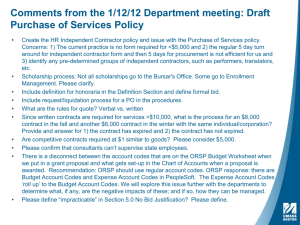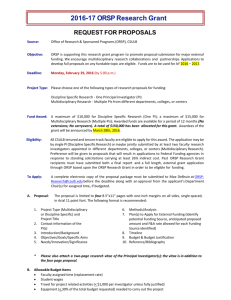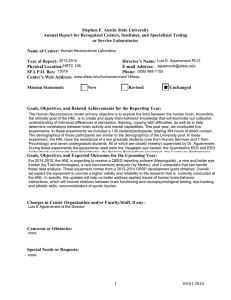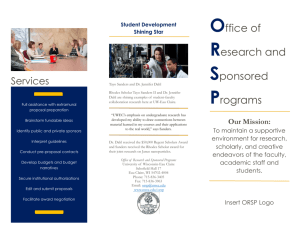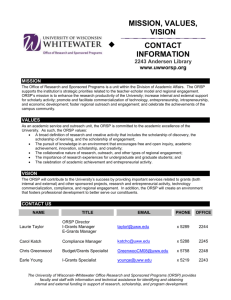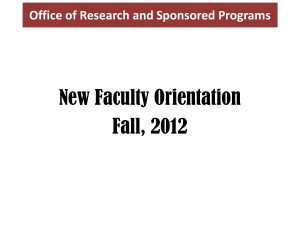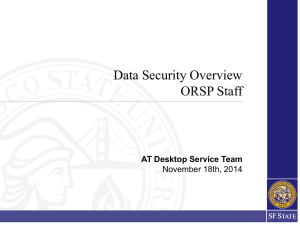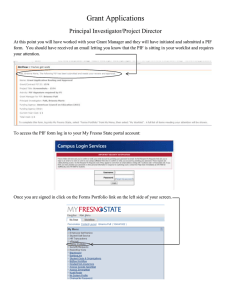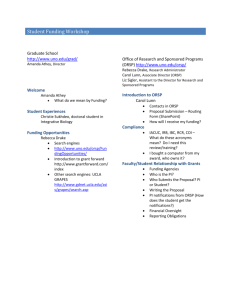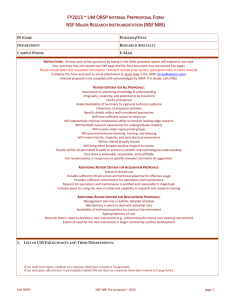URAC Minutes of Meeting Aug 2015
advertisement
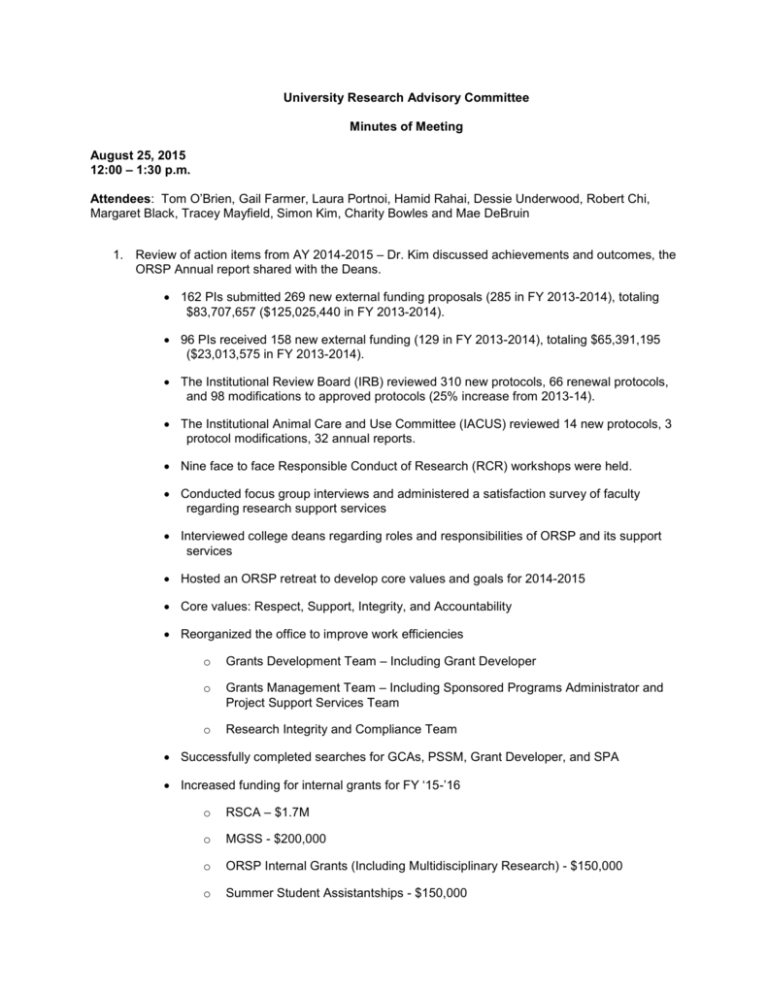
University Research Advisory Committee Minutes of Meeting August 25, 2015 12:00 – 1:30 p.m. Attendees: Tom O’Brien, Gail Farmer, Laura Portnoi, Hamid Rahai, Dessie Underwood, Robert Chi, Margaret Black, Tracey Mayfield, Simon Kim, Charity Bowles and Mae DeBruin 1. Review of action items from AY 2014-2015 – Dr. Kim discussed achievements and outcomes, the ORSP Annual report shared with the Deans. 162 PIs submitted 269 new external funding proposals (285 in FY 2013-2014), totaling $83,707,657 ($125,025,440 in FY 2013-2014). 96 PIs received 158 new external funding (129 in FY 2013-2014), totaling $65,391,195 ($23,013,575 in FY 2013-2014). The Institutional Review Board (IRB) reviewed 310 new protocols, 66 renewal protocols, and 98 modifications to approved protocols (25% increase from 2013-14). The Institutional Animal Care and Use Committee (IACUS) reviewed 14 new protocols, 3 protocol modifications, 32 annual reports. Nine face to face Responsible Conduct of Research (RCR) workshops were held. Conducted focus group interviews and administered a satisfaction survey of faculty regarding research support services Interviewed college deans regarding roles and responsibilities of ORSP and its support services Hosted an ORSP retreat to develop core values and goals for 2014-2015 Core values: Respect, Support, Integrity, and Accountability Reorganized the office to improve work efficiencies o Grants Development Team – Including Grant Developer o Grants Management Team – Including Sponsored Programs Administrator and Project Support Services Team o Research Integrity and Compliance Team Successfully completed searches for GCAs, PSSM, Grant Developer, and SPA Increased funding for internal grants for FY ‘15-’16 o RSCA – $1.7M o MGSS - $200,000 o ORSP Internal Grants (Including Multidisciplinary Research) - $150,000 o Summer Student Assistantships - $150,000 Provided webinars through Grant Resource Center for faculty for grant opportunities searching Created a clearinghouse for successful grant proposals o Copyright issue on faculty paper. The publisher usually owns the copyright, ie journals. o The university is not touching on policy. RSCA papers depends on agreement with the sponsor or publication. o Intellectual Property Policy – Chancellor’s Office will finally work on it but mostly on course material copyright. o Clearing House is available through Beachboard. Published ORSP Monthly Newsletter Publish an annual Research Achievement Report – end of Oct ’15 o 20 pages, both hardcopies and online o Dessie Underwood recommends undergrad research focus to attract talented high school students to come to CSULB o Colleges or Units not highlighted currently will be highlighted in the next issue. Produced the 2013-2014 ORSP Annual Report Update ORSP website – Ongoing PI Recognition receptions 2. Action items for FY 2015-2016? A. Improving communication—reduce e-mail attachments? Pre-award clearance process is more streamlined with specific required forms suitable for individual grants. Links are attached rather than individual files. B. Providing support to PIs a. Shorten the time to set up awards in Data warehouse Sponsored Program Specialist (SPA, Nazareth Lijiam) was hired to bridge the gap between Pre-Award and Post-Award process. The SPA receives all the awards before it gets to Post-Award (GCA) to set up the award. The process is continually being streamlined. b. Shorten time for PO (from time of request to time of issue) c. Shorten time for reimbursements (have gone from two weeks to closer to one month in some cases). A Project Support Services Manager (PSSM, Maria Reyes) and Faculty Liaison (Carmen Flores) are available to assist PI and faculty to process their PO or reimbursement requests. ORSP have to coordinate this issue with Research Foundation who cuts the checks. Research Foundation process check payments only twice a week. C. Cultivating Research Environment a. b. Increase Summer Student Assistantship Funds Current budget is about $150K. Dr. Kim will review fund availability. Better timeline for i. RSCAs so that faculty can plan (e.g., Fall deadline; notification by January) It is Chancellor’s policy that new faculty are prohibited to compete from RSCA funding in their first 3 years. COE is giving research funding opportunity to new faculty. ii. Master schedule for different awards and application (Sabbaticals, MGSS, RSCA/SFG, ORSP awards) Timeline/Schedule is done and Dr. Kim will email to URAC. c. Research Deal with CSU research culture - Balance between Teaching Agenda and i. Don’t just ask people to volunteer their personal time to do research; provide more time What incentives are given to faculty to do research? Faculty Researcher can be given 9 WTU instead of 12 WTU. 3 WTU needs to get funded. ii. “bait and switch” from faculty hire to actual assignments and RTP (we hire base on academics, research, but when new faculty get here the teaching load prevents them from doing research) CSU San Diego model is 3/3. CSULB faculty gets 4/4. Reducing teaching load vs less class with more students. CSU is not an R01 organization and faculty are not compensated in everything they do. iii. Each college needs a dedicated Associate Dean for Research 1. Provide outreach to faculty 2. Provide mentorship to faculty 3. Identify incentives for faculty to submit grant 4. Provide the time needed to support faculty 5. Key is dedicated support and not “add on” job The AVP needs to sell this concept to the Deans. Currently, Associate Deans or Director for Research are given split appointments iv. Establish mentorship for grant writing with outside, R01 researchers 1. Program where faculty proposes to write a research proposal with an R01 partner (release time for faculty, $5K for research mentor) Need to develop a structure/model to implement. 2. Enables very specific support to help faculty become successful grant writers in new areas Grant Writing workshops must be college specific. A Proposal Development Specialist (Jacquie Wilvers) is hired and available to assist faculty in proposal development. Funding Agencies Program Officers are invited to give presentations to CSULB Faculty. On September 24th – the Deputy Assistant Secretary for Higher Education from US Department of Education and on September 25th – An NSF Program Director for the Division of Environmental Biology, will come to CSULB to meet with interested faculty and give a presentation. 3. v. vi. Suggestions or recommendation on which agency to invite are being asked from the faculty researchers or URAC. Tracey suggested IMLS (Institute of Museum and Library Services) for COTA or Library researchers and grant seekers. COTA recommends NEH. Funding Agencies with smaller indirect costs, ie Foundations, are also encouraged for submission. ORSP AVP will be responsible in monitoring indirect costs. In-house mentors by grant areas (NSF, NIH, NASA, Fellowships, etc.) May start in each college and then branch out. In COE, a Faculty Supervision Incentive Program is started to give .67 unit credit to faculty who supervise a thesis or research project; the credit can be accumulated up to 6 units. Reduce teaching load – part of earlier discussion Hamid’s 6K for buyout! Vacant rate vs actual replacement rate/cost Replacement cost is less than vacant rate 3. Internal Grants – Modified timeline – Dr. Kim will email URAC the new timeline. 4. Future Meetings – September 22, 2015 Draft Respectfully Submitted by: Mae DeBruin on August 28, 2015.
